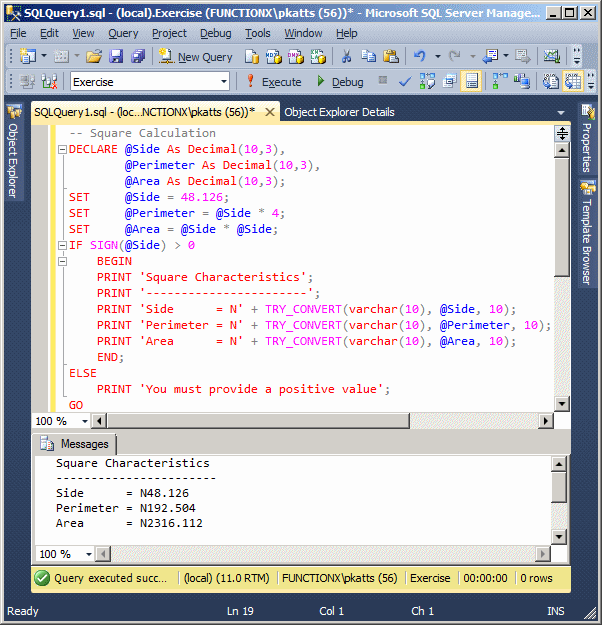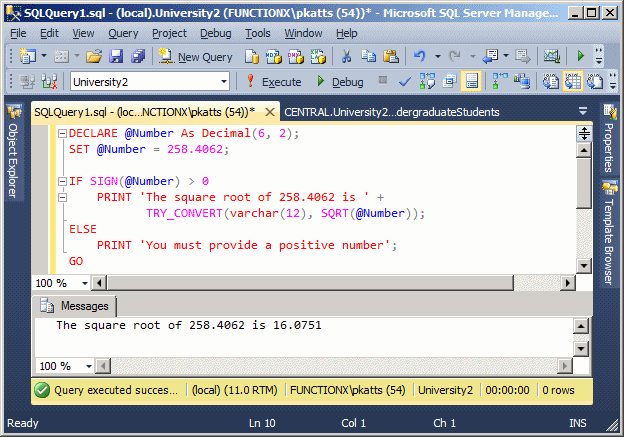In most cases, a value the user submits to your database is primarily considered a string. This is convenient if that's what you are expecting. If the value the user provides must be treated as something other than a string, for example, if the user provides a number, before using such a value, you should first convert it to the appropriate type, that is, from a string to the expected type. To assist with conversion, you can use either the CAST() or the CONVERT() function. The syntax of the CAST() function is: CAST(Expression AS DataType) The Expression is the value that needs to be cast. The DataType factor is the type of value you want to convert the Expression to. The DataType can be one of those we reviewed in Lesson 5.
From here to the end of this lesson, all instructions are intended for All Computers:
A macro is an action that can be performed on a database or certain parts of a database or of a database server. A macro resembles a function without being exactly one. Transact-SQL provides various macros to assist you with managing databases and their objects.
In the DatabaseName placeholder, you can enter the name of the database.
The string is the most basic, the primary value that is presented to a database. This is because, any value, before being treated particularly, is firstly considered a string. In an application, there are various ways you use or get a string. You can get it or provide it to a function as a constant string, that is, a string whose value you know certainly and that you pass to a function. You can also get a string that a user provides. Other functions also can produce or return a string. To assist you with managing strings or performing operations on them, Transact-SQL provides various functions. The functions can divide in categories that include character-based, conversions, addition, sub-strings, etc. Some operations performed on strings require that you know the number of characters of a string. This is because some operations require a minimum number of characters and some other functions require that the string have at least one character. The number of characters of a string is also called the length of the string. To get the length of a string, you can use the LEN() function. Its syntax is: int LEN(String) This function takes one argument as the string to be considered. It returns the number of characters in the string.
As you may know already, a string is primarily one or a group of characters. These characters are ASCII values. If you have a string, to get the ASCII code of its leftmost character, you can use the ASCII() function. Its syntax is: int ASCII(String) This function takes as argument as string and returns the ASCII code of the first (the left) character of the string.
If you have the ASCII code of a character and want to find its actual character, you can use the CHAR() function. Its syntax is: char CHAR(int value) This function takes as argument a numeric value as an integer. Upon conversion, the function returns the ASCII equivalent of that number. As you may know already, a string can be made of uppercase, lowercase, and symbols that doN't have a particular case. When you receive a string, if you want to convert all of its characters to lowercase, you can use the LOWER() function. Its syntax is: varchar LOWER(String) This function takes as argument a string. Any lowercase letter that is part of the string would not change. Any letter that is part of the string would be converted to lowercase. Any other character or symbol would be kept "as is". After conversion, the LOWER() function returns a new string. Here is an example: DECLARE @FIFA varchar(120) SET @FIFA = N'F�d�ration Internationale de Football Association' SELECT @FIFA AS FIFA SELECT LOWER(@FIFA) AS Converted This would produce:
Instead of the starting characters of a string, you may want to create a string using the most-right characters of an existing string. To support this operation, Transact-SQL provides the RIGHT() function. Its syntax is: varchar RIGHT(String, NumberOfCharacters) This function takes two arguments. The first argument specifies the original string. The second argument specifies the number of characters from the most-right that will constitute the sub-string.
or binary REPLACE(String, FindString, ReplaceWith) This function takes three arguments. The first is the string that will be used as reference. The second argument, FindString, is a character or a sub-string to look for in the String argument. If the FindString character or sub-string is found in the String, then it is replaced with the value of the last argument, ReplaceWith.
In arithmetic, a number is considered as being negative (less than 0), null (equal to 0), or positive (higher than 0). When a number is negative, it must have a - symbol to its left. If it is positive, it may display a + symbol to its left or it can omit it. A number without the - or + symbol to its left is considered positive, also referred to as unsigned. The symbol that determines whether a number is positive or negative is referred to as its sign. The sign is easily verifiable if you know the number already. In some cases, when a number is submitted to your application, before taking any action, you may need to get this piece of information. To find out if a value is positive, null, or negative, Transact-SQL provides the SIGN() function. Its syntax is: SIGN(Expression) This function takes as argument a number or an expression that can be evaluated to a number. The interpreter would then examine the number:
Based on this, you can use the SIGN() function to find out whether a value is negative, null, or positive: simply pass the value (or a variable) to SIGN() and use a logical operator to check its sign. Here is an example: -- Square Calculation
DECLARE @Side As Decimal(10,3),
@Perimeter As Decimal(10,3),
@Area As Decimal(10,3);
SET @Side = 48.126;
SET @Perimeter = @Side * 4;
SET @Area = @Side * @Side;
IF SIGN(@Side) > 0
BEGIN
PRINT 'Square Characteristics';
PRINT '-----------------------';
PRINT 'Side = N' + CONVERT(varchar(10), @Side, 10);
PRINT 'Perimeter = N' + CONVERT(varchar(10), @Perimeter, 10);
PRINT 'Area = N' + CONVERT(varchar(10), @Area, 10);
END;
ELSE
PRINT 'You must provide a positive value';
GO
Here is an example of executing the statement:
Here is another example of executing the statement:
Notice that the interpreter acts differently in response to the result of the SIGN() function.
The decimal numeric system counts from minus infinity to infinity. This means that numbers are usually negative or positive, depending on their position from 0, which is considered as neutral. In some operations, the number considered will need to be only positive even if it is provided in a negative format. The absolute value of a number x is x if the number is (already) positive. If the number is negative, its absolute value is its positive equivalent. For example, the absolute value of 12 is 12, while the absolute value of -12 is 12. To get the absolute value of a number, you can use the ABS() function. Its syntax is: ABS(Expression) This function takes an expression or a number as argument and returns its absolute value. Here is an example: DECLARE @NumberOfStudents INTEGER; SET @NumberOfStudents = -32; SELECT ABS(@NumberOfStudents) AS [Number of Students]; GO This would produce:
Consider a decimal value such as 12.155. This number is between integer 12 and integer 13  In the same way, consider a number such as –24.06. As this number is negative, it is between –24 and –25, with –24 being greater. In algebra, the ceiling of a number is the closest integer that is greater than or higher than the number considered. In the first case, the ceiling of 12.155 is 13 because 13 is the closest integer greater than or equal to 12.155. The ceiling of –24.06 is –24. To get the ceiling of a number, Transact-SQL provides the CEILING() function. Its syntax is: CEILING(Expression) This function takes as argument a number or an expression that can evaluate to a number. After the conversion, if the function succeeds, it returns a double-precision number that is greater than or equal to Expression. Here is an example: DECLARE @Number1 As Numeric(6, 2),
@Number2 As Numeric(6, 2)
SET @Number1 = 12.155;
SET @Number2 = -24.06;
SELECT CEILING(@Number1) AS [Ceiling of 12.155],
CEILING(@Number2) AS [Ceiling of �24.06];
GO
This would produce:
Here is another way of displaying the above results: DECLARE @Number1 As Numeric(6, 2),
@Number2 As Numeric(6, 2)
SET @Number1 = 12.155;
SET @Number2 = -24.06;
PRINT 'The ceiling of 12.155 is ' +
CONVERT(varchar(10), CEILING(@Number1));
PRINT 'The ceiling of �24.06 is ' +
CONVERT(varchar(10), CEILING(@Number2));
GO
This would produce:
Consider two decimal numbers such as 128.44 and -36.72. The number 128.44 is between 128 and 129 with 128 being the lower. The number –36.72 is between –37 and –36 with –37 being the lower. The lowest but closest integer value of a number is referred to as its floor. Based on this, the floor of 128.44 is 128. The floor of –36.72 is –37. To support finding the floor of a number, Transact-SQL provides the FLOOR() function. Its syntax is: FLOOR(Expression) The FLOOR() function takes as argument a numeric value or an expression that can be evaluated to a number. If the function succeeds during its conversion, it produces the integer that is the floor of the argument. Here is an example: DECLARE @Number1 As Numeric(6, 2),
@Number2 As Numeric(6, 2);
SET @Number1 = 128.44;
SET @Number2 = -36.72;
SELECT FLOOR(@Number1) AS [Floor of 128.44],
FLOOR(@Number2) AS [Floor of �36.72];
GO
This would produce:
|
|
|||||||||||||||||||||||||||||||||||||||||||||||||||||||||||||||||||||||||||||||||||
|
|
||||||||||||||||||||||||||||||||||||||||||||||||||||||||||||||||||||||||||||||||||||









































